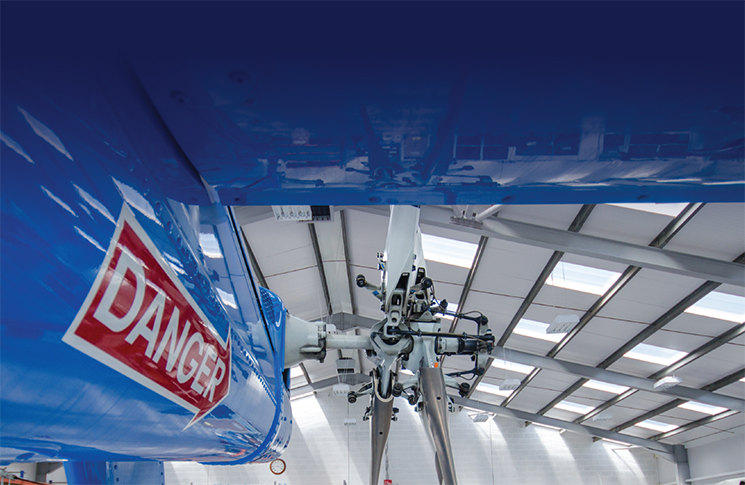Safety in the hangar is an important aspect of aviation safety that is worth brushing up on.
‘Airplanes may kill you but they ain’t likely to hurt you,’ the accomplished but aerophobic baseball pitcher Leroy ‘Satchel’ Paige famously said. Unfortunately, this isn’t true about aircraft in the hangar. Aircraft maintenance can be a hazardous occupation in its own right, quite apart from the importance for flight safety of doing the job properly.
Aircraft maintenance is the top area for civilian worker injuries in the US Air Force, resulting in 33% of all lost workdays from 1993 to 2002.
In 2018, the US Bureau of Labor Statistics found aircraft service technicians had more than 4 times as many occupational injuries involving days away from work than pilots, co-pilots and flight engineers (186.3 vs 39.3 per 10,000 full-time workers).
American statistics also suggest that the COVID-19 pandemic had an indirect effect on maintenance worker safety from the disruption, interruption and retirement of senior personnel. The US Occupational Safety and Health Administration last year reported, ‘In 2022, there were 30 severe mechanic injuries, defined as injuries requiring amputation or in-patient hospitalisation or involving loss of an eye. This is the highest annual total since the administration began reporting these injuries in 2015. It compares with an average of 15 annual injuries during 2015–21 and the highest previous annual count of 19 in 2017.’
Safety in the hangar is covered by overlapping regulations. Generally, CASA does not oversee workplace health and safety as state governments have charge on this subject; however, some safety items required for issue of CAR 30 or CASR Part 145 authorisations would be expected to be adhered to, such as tyre inflation cages, safety harnesses and barriers. A maintenance and repair organisation would be expected to maintain and use this equipment in accordance with published instructions for continued airworthiness.
Maintenance accidents can be horrific.
- In May 2015, an engineer at Istanbul airport was killed in a maintenance hangar when his head was caught between retracting flaps on a Boeing 777.
- In December 2015, an engineer at Mumbai airport was ingested into a jet engine after helping the flight crew with a cross-bleed start during pushback.
- In July 2019, a 22-year-old engineer was killed at Kolkata airport when the landing gear doors on a Bombardier Q400 closed while he was repairing the right-hand side main gear.
- In December 2020, an engineer was crushed by a pushback tug he was servicing in a hangar at Chicago O’Hare Airport.
- In December 2021, a 63-year-old engineer fell from an aircraft at Singapore Changi Airport and died from injuries 2 weeks later.
- In November 2023, an Air India engineer slipped off stairs at Delhi airport while working on an aircraft radome and died from head injuries.
- In February 2024, a China Airlines engineer was crushed to death by retracting landing gear in a maintenance centre at Taipei Taoyuan Airport.
Different types of aircraft bring their own repertoire of hazards into the hangar. Smaller general aviation types bring the dangers of magneto ignition propeller engines that must always be considered potentially live. A less fatal but distinct hazard is that of walking into the often head-high and sometimes painfully sharp edges of wings. (Any LAME who hasn’t done this is either new or a specialist in low-wing types.) Large aircraft bring the hazard of falls from height and crush injuries from hydraulic or electrical systems. All aircraft carry the risk of fire during maintenance.
Six hurtful things
Fire
Overhaul, repair and service of any powered aircraft involves a potential fire hazard because the factors that make fire so dangerous in the sky are also present on the ground – volatile fuel, high-energy electrical systems and flammable structures. Particular risks include:
- Aircraft fuel system maintenance involving fuel storage and transfer. All operations involving gasoline and fuels with a flash point under 38 degrees C (such as aviation gasoline) must be done outside. The fuels allowed in hangars present a fire risk if located where open flame or spark-producing equipment is used.
- Electrical equipment such as power units, aircraft electrical systems and chargers are possible ignition sources that must be kept separated from the fuel system, including aircraft fuelling points, tank vents and fuel line drains, which may be hard to see. Cordless tools using brushed electric motors are spark generators that have produced fatal accidents when used near aircraft fuel systems, even when they are empty.
- Aircraft breathing systems, whether using bottled oxygen or chemical oxygen generators, should only be maintained and recharged outside the hangar.
- Welding must be completely isolated from hazardous activities such as fuel transfer or painting.
“The factors that make fire so dangerous in the sky are also present on the ground.
Electric shock
With 58 km of wiring in a Boeing 737-700 aircraft, running at 115–120 volts AC or 14/28 volts DC, large aircraft electrical systems are inherently complex, and sometimes degraded by age.
The US Navy has this to say about the dangers of aircraft electric and avionics systems in maintenance. ‘Electric shock, burns and fire are potential hazards from working with electrical systems. To mitigate these risks, personnel should always follow established safety protocols and wear appropriate personal protective equipment (PPE), such as insulated gloves, safety goggles and flame-retardant clothing.’
In addition to PPE, aircraft maintainers must also use special tools and equipment designed for electrical work. For example, tools such as insulated screwdrivers and pliers help prevent electric shock and reduce the risk of short circuits. Aircraft maintainers must regularly inspect tools and equipment to ensure they are in good condition and free from defects.
Earthing electrical equipment helps prevent electric shock and reduces the risk of fires. All equipment must be properly earthed (or grounded, in American English) before work on electrical systems. Regular inspections and maintenance can help identify electrical issues before they become problems or failures. This includes checking for loose connections, worn or damaged components, split, overheated, chaffed or damaged wiring, signs of arcing and signs of corrosion.
Lockout tags notify maintainers they cannot apply electrical power to the aircraft. The tags can take the form of a sign at the entrance of the cockpit, or on the external power connection point and in the aircraft maintenance log.
Electricity is also an ignition source and particularly dangerous in the presence of fumes or combustible materials.
Chemical exposure
Working on aircraft means working near fuels, lubricants, coolants, cleaning solutions, including solvents and adhesives. All of these can be harmful if swallowed, breathed in, or absorbed through the skin. Composite materials including fibreglass and carbon fibre can cause dermatitis and a growing body of evidence is linking breathing in carbon fibre dust to mesothelioma.
PPE, including gloves, masks, respirators, cloaks, gowns and shoe covers, is the best way to counter these hazards.
Painting large aircraft is a significant challenge for hangar fire protection and not surprisingly, is usually delegated to specialists. Unlike motor vehicles or smaller aircraft whose components can be painted in booths then assembled, aircraft exterior painting involves workers using spray guns at height, with the risk of a fall added to the hazards of flammable paint plumes.
Noise
A noisy aircraft hangar is both a hazard in itself, if the continuous noise level exceeds 85 dBA and is a contributor to another insidious hazard – miscommunication.
A report published in Safety Science in September 2021 found 5 reported near misses and injuries associated with ergonomic, fall, housekeeping and communication issues; noise above 85 dBA was present during 4 of these events.
Heights
Working at heights is a high-risk activity, and a leading cause of death and serious injury in Australia. Falls are mostly a scourge of the construction industry but are also a hazard in aviation maintenance. The shape of aircraft and the need to avoid damaging aircraft surfaces add to risks in the hangar, which include falling and dropping tools.
Falls are not just a risk for engineers working on large aircraft, which can involve tasks done 20 metres above the floor. A 2008 study in the Journal of Safety Research found about one in 7 fatal falls were from 3 metres or less.
Fall protection gear, such as harnesses and lanyards, may be sometimes inconvenient but they reduce the danger of falls.
“A 2008 study in the Journal of Safety Research found about one in 7 fatal falls were from 3 metres or less.
Crush injuries
These can range from a nipped finger refitting an engine cylinder to a grotesque fatality. Serious crush injuries often involve the aircraft’s hydraulic and electrical systems.
Boeing has introduced the concept of aircraft hazardous energy whether electrical, thermal, pneumatic, hydraulic or mechanical as a maintenance hazard, and has this to say. ‘Hazardous energy controls are required when technicians could be exposed to unexpected energization, startup, or release of hazardous energy during service or maintenance activities.’
Communication failures or deviations from standard procedures are often factors in crush accidents, which of course are not unique to aviation. A safety methodology used in mining and industry is lockout, tagout, tryout (LOTO).
LOTO’s general principles are to:
- lockout the system in question by either depowering it or blocking it, for example, with a locking pin for landing gear
- tagout the system, placing prominent warnings on it and in workplace meetings to ensure it is not repowered until safe
- tryout the system from a safe operator’s position to be sure it has no residual electricity (from capacitor) or no residual air, gas or hydraulic pressure.
Non-accident injuries
An insidious form of harm is the range of injuries incurred when working in the hangar. These can be thought of in 2 ways: as a non-accident injury or as an accident that happens in slow motion, over days, weeks, months or years.
A 2023 Embry-Riddle Aeronautical University study found, ‘Aviation mechanics are subjected to awkward postures like bending, twisting, heavy load carrying, etc.’ The use of a rapid entire body assessment ergonomic tool to measure these generated a score of 9, in the high-risk range.
‘However, there are other factors contributing to the existence of musculoskeletal disorders such as prolonged standing and repetitive movement,’ the authors said. ‘We recommend engineering controls such as chairs, mats and equipment-handling tools to positively impact aviation mechanics’ risk.’
Other studies have found lower back pain rates of up to 65% among surveyed aircraft maintenance technicians. These were linked to bending and working with twisted trunks, lifting of aircraft parts, high physical loads and extended overhead activity.
Studies have also suggested that the duration of employment and the engineers’ time in the office may also be predictors for work-related musculoskeletal injuries.
The SMS dividend
There are many countermeasures an individual can take to avoid the hazards of the hangar. They range from LOTO to using harness systems to guard against falls, air tools to avoid accidental ignition, insulated tools as a last-ditch against electric shock, or work platforms and other ergonomic aids as a countermeasure for chronic injury.
However, the greatest safety aid is an intangible: a safety management system (SMS) as required by Part 145-approved maintenance organisations. When properly implemented, an SMS will not only identify and mitigate maintenance related hazards to flight, but will also perform an occupational health and safety function.
SMS is based on 4 conceptual pillars:
- safety policy, in which senior management demonstrates its commitment to ongoing safety improvement
- safety risk management, which uses a formal process to assess the need for new or improved risk controls based on acceptable risk levels
- safety assurance, which evaluates the ongoing effectiveness of risk control strategies
- safety promotion, which focuses on creating a positive safety culture at all workforce levels.
“A culture that allows and rewards analysis, prudence, procedure and review is as necessary on the ground as it is in the air.
Aviation and other industries have many case studies of organisations that have reaped safety and business benefits from adopting and persisting with SMS. Individuals can and should be careful, regardless of their surrounds, but putting in place a culture that allows and rewards analysis, prudence, procedure and review is as necessary on the ground as it is in the air.
Further information
- Asadi, H., Yi, D., & Mott, J. H. (2019). Risk factors for musculoskeletal injuries in airline maintenance, repair & overhaul. Science Direct. Vol. 70.
- Gupta, SS., Singh, KP., Gupta, S., Dusinska, M., Rahman, Q. Do Carbon Nanotubes and Asbestos Fibers Exhibit Common Toxicity Mechanisms? Nanomaterials (Basel). 2022 May 17;12(10):1708. doi: 10.3390/nano12101708. PMID: 35630938; PMCID: PMC9145953.
- Nitch, S., Nelson, K., & Williamson, A. (2023). Scholarly Commons | Embry-Riddle Aeronautical University Research.





